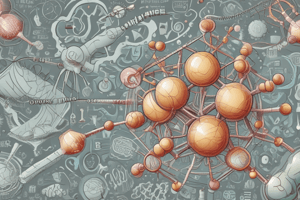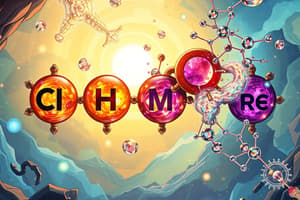Podcast
Questions and Answers
Which of the following processes is primarily involved in the conversion of inorganic nitrogen into organic forms?
Which of the following processes is primarily involved in the conversion of inorganic nitrogen into organic forms?
What is the primary purpose of lithotrophy in metabolism?
What is the primary purpose of lithotrophy in metabolism?
Which of the following processes is primarily responsible for the generation of ATP through substrate-level phosphorylation?
Which of the following processes is primarily responsible for the generation of ATP through substrate-level phosphorylation?
In terms of bioenergetics in the cytosol, which of the following is NOT a common function of cytosolic pathways?
In terms of bioenergetics in the cytosol, which of the following is NOT a common function of cytosolic pathways?
Signup and view all the answers
Which carbon dioxide fixation pathway would you expect to be less efficient under low CO2 concentrations?
Which carbon dioxide fixation pathway would you expect to be less efficient under low CO2 concentrations?
Signup and view all the answers
In bioenergetics, which high-energy molecule is crucial for transferring phosphate groups during biosynthesis?
In bioenergetics, which high-energy molecule is crucial for transferring phosphate groups during biosynthesis?
Signup and view all the answers
Which statement best describes the methylotrophs in the context of C1 metabolism?
Which statement best describes the methylotrophs in the context of C1 metabolism?
Signup and view all the answers
What is the primary fate of NADH produced during glycolysis?
What is the primary fate of NADH produced during glycolysis?
Signup and view all the answers
Which statement accurately describes the significance of conformational changes in regulatory enzymes?
Which statement accurately describes the significance of conformational changes in regulatory enzymes?
Signup and view all the answers
What is considered a key feature of C1 metabolism?
What is considered a key feature of C1 metabolism?
Signup and view all the answers
Which metabolic process is primarily involved in the conversion of carbohydrates into alcohol or acids without the use of oxygen?
Which metabolic process is primarily involved in the conversion of carbohydrates into alcohol or acids without the use of oxygen?
Signup and view all the answers
Which pathway best describes the metabolic cycling of carbon compounds in organisms that can utilize one-carbon substrates?
Which pathway best describes the metabolic cycling of carbon compounds in organisms that can utilize one-carbon substrates?
Signup and view all the answers
Which of the following processes occur in the cytosol and is crucial for cellular energy production?
Which of the following processes occur in the cytosol and is crucial for cellular energy production?
Signup and view all the answers
What cellular structure is primarily responsible for maintaining the integrity and regulation of cellular transport mechanisms?
What cellular structure is primarily responsible for maintaining the integrity and regulation of cellular transport mechanisms?
Signup and view all the answers
In terms of inorganic metabolism, which element is primarily utilized by organisms for energy and is essential for various biochemical processes?
In terms of inorganic metabolism, which element is primarily utilized by organisms for energy and is essential for various biochemical processes?
Signup and view all the answers
Signup and view all the answers
Flashcards
Nitrate Assimilation
Nitrate Assimilation
The process of transforming inorganic nitrogen, in the form of nitrate (NO3-) or nitrite (NO2-), into organic nitrogen compounds like amino acids and proteins that are essential for life.
Nitrogen Dissimilation
Nitrogen Dissimilation
The process of breaking down organic nitrogen-containing compounds, like amino acids and proteins, into inorganic nitrogen compounds like ammonia (NH3), nitrite (NO2-) or nitrate (NO3-) .
Nitrogen Fixation
Nitrogen Fixation
The process of converting atmospheric nitrogen gas (N2) into ammonia (NH3) by certain microorganisms, making nitrogen available to living organisms.
Lithotrophy
Lithotrophy
Signup and view all the flashcards
Carbon Dioxide Fixation
Carbon Dioxide Fixation
Signup and view all the flashcards
Bioenergetics
Bioenergetics
Signup and view all the flashcards
High-Energy Molecules
High-Energy Molecules
Signup and view all the flashcards
Glycolysis
Glycolysis
Signup and view all the flashcards
Substrate-Level Phosphorylation
Substrate-Level Phosphorylation
Signup and view all the flashcards
Group Transfer Reaction
Group Transfer Reaction
Signup and view all the flashcards
Photosynthesis
Photosynthesis
Signup and view all the flashcards
Biofilms
Biofilms
Signup and view all the flashcards
Cellular Respiration
Cellular Respiration
Signup and view all the flashcards
Active Transport
Active Transport
Signup and view all the flashcards
Study Notes
Chapter 13: Inorganic Metabolism
- Covers nitrate and sulfate assimilation and dissimilation
- Discusses nitrogen fixation
- Includes a section on lithotrophy
- Provides a summary of inorganic metabolism
Chapter 14: C1 Metabolism
- Explores carbon dioxide fixation systems
- Describes growth on one-carbon compounds (C1) other than CO2, focusing on methylotrophs
- Offers a summary of C1 metabolism
Chapter 15: Regulation of Metabolic Pathways
- Examines patterns of metabolic pathway regulation
- Analyzes kinetics of regulatory and non-regulatory enzymes
- Details conformational changes in regulatory enzymes
- Covers regulation through covalent modification
Chapter 8: Bioenergetics in the Cytosol
- Discusses high-energy molecules and their group transfer potential
- Highlights the role of group transfer reactions in biosynthesis
- Explains ATP synthesis through substrate-level phosphorylation
- Includes a summary of bioenergetics in the cytosol
Chapter 9: Central Metabolic Pathways
- Covers glycolysis in detail
- Discusses the fate of NADH
- Explains the reason for using NAD+ instead of NAD and NADH instead of NADH2.
Studying That Suits You
Use AI to generate personalized quizzes and flashcards to suit your learning preferences.
Related Documents
Description
This quiz covers key topics from chapters 13 to 15 of biochemistry, focusing on inorganic metabolism, C1 metabolism, and the regulation of metabolic pathways. It includes details on nitrate and sulfate assimilation, nitrogen fixation, and the role of regulatory enzymes in metabolism. Enhance your understanding of bioenergetics and metabolic regulation with this comprehensive review.





